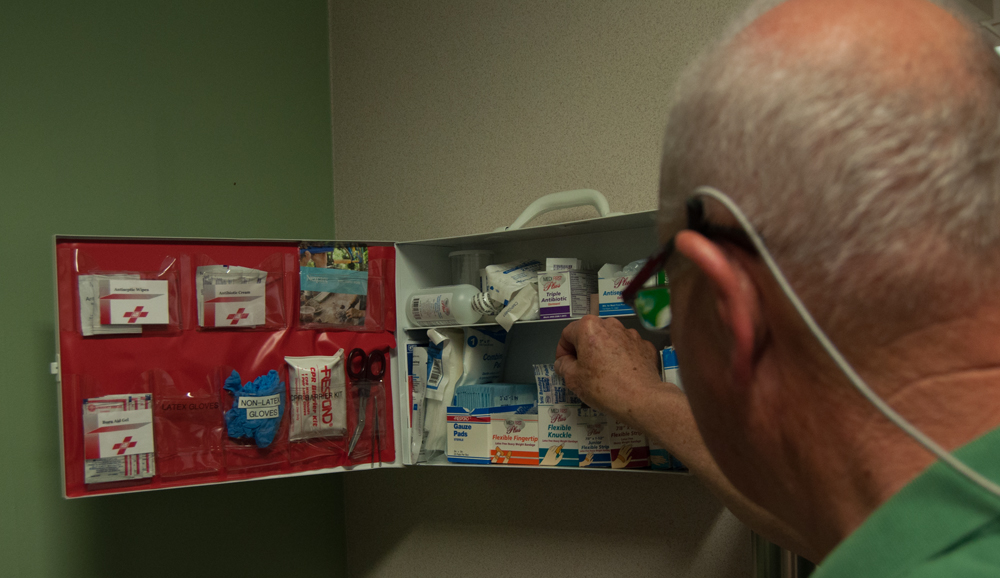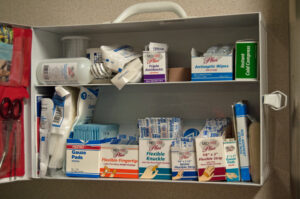Railfan first aid kits might be the furthest thing from your mind when planning a train-themed outing. One, however, might be among the most important — if you have a minor injury or a mild medical reaction to something you come across in the field.
Trains.com exchanged questions via email with Robert W. Scott, Operations Chief for the West Thurston Region Fire Authority in Olympia, Washington, about first aid kits and how and when railfans should use them. Scott is also a noted rail photographer and Trains contributor.

Trains.com: When we go out on a railfan trip, most of us take our railfan gear: radios, cameras, maps, smartphone, snacks, and, hopefully, water. I’m not sure most of us take a first aid kit. Why should we?
Chief Scott: It’s always important to remember that railroads are not always in the most convenient places to handle scrapes and bruises. It’s always a good idea to have some basic first aid supplies at the ready in case you need them.

Trains.com: We’ll always include the basics: band aids, gauze, tape, aspirin, or acetaminophen. But should we be stocking up on certain kinds of these basics? Or will dollar store items be just fine?
Chief Scott: Most items can be found in a one-stop purchase of a commercial first aid kit. This type of kit will have 90% of the things you would need to handle most trackside boo-boos and owies. One thing that most people don’t think about is carrying sting sticks or those topical things you can apply after a bee sting. Those can really assist in providing some temporary relief while waiting for the next train.
Trains.com: Should a kit change depending on where you are going?
Chief Scott: Most first aid kits are generally universal. It’s the secondary items you really need to have with you that are dependent upon where you are going. Warmer climate, you should always carry plenty of water with you at all times, no matter how long you decide you may be out. A flat tire at the end of a forest service road or BLM land could make a quick 45-minute trip into a multihour ordeal. If you run into any issues, you need to be prepared for them.
Trains.com: Do you recommend railfans getting first aid training? If so, are there any national organizations you recommend?
Chief Scott: Red Cross has first aid training available as well as other groups. Learning basic first aid will go far to not only assist you, but in case of an emergency, you can be an integral part of a team that could provide first-on-scene care as well.
Trains.com: Certain outdoor companies sell more serious gear like DIY suture kits, tourniquets, and “trauma” gear. Is that ever appropriate for the railfan to carry?
Chief Scott: Usually, anything that requires more substantial medical intervention should be done by medical professionals. Most of these [kits] are geared toward the ultra-prepared, but provide little guidance. Its best to let the folks in urgent care of the hospital emergency department deal with those situations.
Trains.com: Maybe the best question: What items should EVERY railfan have in their first aid kit before hitting the road?
Chief Scott: Instant-cold ice packs are always a good idea to carry in your kit. They can be used for swelling reduction as well as cooling if you get overheated. Also, a topical that can assist in stopping itching from contact with noxious or poisonous plants such as poison ivy, sumac, or poison oak.














Its important to know the differences between a first-aid kit and a “boo-boo kit”. A first aid kit should contain items used to preserve and save a life. A boo-boo kit is something for life’s little ouchies.
Everyone should carry at least 1 quality tourniquet, and know how to use it. By quality I mean one recommended by the Committee on Tactical Combat Casualty Care (CoTCCC). Yes the name implies focus on military, but if the GWoT taught us anything over the past 21 years, just because something is designed for military use doesn’t mean it doesn’t work in the civilian sector. Quality tourniquets, also known as “TQs” are the SOFT-T Wide, the latest generation (7th) CAT, among just a few others.
Carrying a TQ is nice, but knowing how to use it is just as important. The Red Cross has a free classes called “Stop the Bleed”. Take it! In addition to CPR certs.
In addition to a TQ, a couple of quality pressure bandages like the “Israeli Bandage” or my preferred, the Olaes Modular Bandage. Hemostatic agent such as QuikClot Combat Gauze or Celox isn’t a bad idea. Chest seals are quality.
Seriously, we spend thousands on camera gear, don’t skimp on a $75 trauma kit that is smaller than most DSLRs. Spend some money on a class or two. As mentioned some classes are free. The life you save might be your own, as these classes don’t just teach you how to apply to another, but also to self-apply. It would suck something fierce to die, or watch someone you love die, from exsanguination (blood loss) or a sucking chest wound from a wound when you’re out in the middle of nowhere, and help is half an hour away (or more).